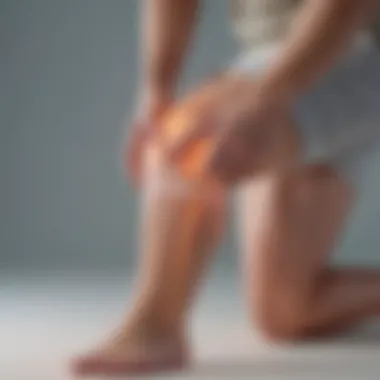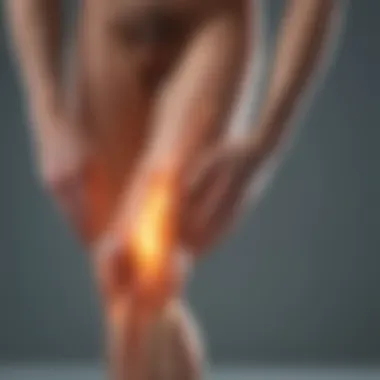Heat or Cold for Arthritic Knee Pain: An In-Depth Analysis


Intro
Knee pain due to arthritis is a common concern among many individuals. It can significantly impact daily activities and overall quality of life. Understanding the mechanisms behind pain relief is essential for those suffering from this condition. Many patients find themselves torn between using heat or cold to manage their pain. While both methods have their advocates, knowing how each works can aid in making an informed decision.
This article seeks to provide clarity on the subject by delving into the physiological effects of heat and cold applications. We will explore the effectiveness of these modalities based on clinical observations and studies. Furthermore, we will discuss how personal circumstances and preferences shape the choice of treatment. Through this analysis, we aim to equip patients and healthcare providers with evidence-based knowledge to enhance the management of knee arthritic pain.
Research Context
Background and Rationale
The use of heat and cold therapies dates back centuries. Each method offers distinct physiological benefits. Heat can promote blood circulation, whereas cold can reduce inflammation and numb sharp pain. As arthritis affects millions worldwide, it is crucial to investigate these treatments further.
Patients often seek instant relief, leading to a preference of one over the other. However, this preference may not be ideal for every individual or situation. As such, understanding when to apply each type of therapy can lead to better pain management strategies.
Literature Review
Several studies focus on the impact of thermal therapies. Research indicates that participants experienced relief from pain when utilizing heat or cold. A review of these findings shows varied responses based on individual factors such as the type of arthritis, stage of the condition, and personal pain thresholds.
Studies compare the effectiveness of heat and cold therapy, offering valuable insights into situations where one may be more beneficial than the other. These studies underscore the importance of tailoring treatments to the patient’s unique needs, rather than applying a one-size-fits-all approach.
Methodology
Research Design
To evaluate the effectiveness of heat and cold therapies, a mixed-methods approach can be beneficial. This allows for a comprehensive understanding of both quantitative and qualitative data. The design will include controlled clinical trials alongside participant interviews to gather subjective experiences.
Data Collection Methods
Data will be collected through a combination of randomized controlled trials, surveys, and interviews. The randomized trials will assess the physical outcomes associated with each treatment. Surveys will allow broader data collection on patient preferences and perceived efficacy. Finally, interviews will provide deeper insights into individual experiences with heat and cold therapy.
Through this structured approach, the analysis can result in a clearer understanding of the optimal use of heat and cold in managing knee pain caused by arthritis. This information ultimately aims to foster better therapeutic choices for patients.
Intro to Arthritis and Knee Pain
Arthritis is a term that describes a group of more than 100 diseases affecting the joints, causing pain, swelling, and stiffness. Knee pain, in particular, is a common ailment that affects many individuals worldwide. Understanding the ways to manage this pain is essential for improving the quality of life among those afflicted by arthritis.
The significance of addressing knee pain from arthritis cannot be overstated. With an increasing aging population, the prevalence of arthritic conditions continues to rise. This section serves as a foundation for exploring effective treatment methods, specifically heat and cold therapies, which are often used to alleviate discomfort associated with knee arthritis.
Understanding Arthritis
Arthritis can manifest in different forms, such as osteoarthritis and rheumatoid arthritis. Osteoarthritis is the most common type, related to wear and tear of the cartilage that cushions the joints. In contrast, rheumatoid arthritis is an autoimmune condition that leads to inflammation in various joints, including the knees.
The difference in these conditions plays a significant role in how patients experience pain and respond to treatments. For example, osteoarthritis pain may intensify with movement, while rheumatoid arthritis pain often fluctuates based on periods of increased inflammation.
Prevalence and Impact of Knee Pain
Knee pain from arthritis is prevalent among older adults, with research suggesting that over 30% of adults aged 65 and older live with chronic knee pain due to arthritis. This issue is not only a medical concern but also a societal one.
Chronic pain affects daily activities, from walking to standing up. It leads to reduced physical activity, ultimately worsening mobility and overall health. Additionally, the emotional and mental health perspective cannot be ignored, as many patients report feelings of frustration or depression attributable to their persistent pain.
"Chronic knee pain can significantly hinder individuals' ability to maintain an active lifestyle, which is crucial for both physical and mental well-being."


While much attention has been devoted to medical treatments, the role of non-pharmacological approaches, such as heat and cold therapy, merits exploration. As these therapies are accessible and can be self-administered, they offer a practical option for pain management in daily life.
The Mechanisms of Pain in Arthritis
Understanding the mechanisms of pain in arthritis is essential for effective management of knee pain. These mechanisms dictate how pain sensation is generated and perceived, influencing treatment choices. Various types of arthritis affect individuals differently, leading to distinct pain profiles that need tailored approaches in therapy. A clear grasp of these pain mechanisms aids both patients and healthcare providers in making informed decisions about using heat or cold therapies.
Biological Basis of Pain Perception
Pain perception in arthritis involves complex interactions among several biological factors. It begins at the nociceptors, specialized nerve endings that respond to harmful stimuli. When tissues become damaged due to arthritis, these nociceptors send signals through nerve fibers to the spinal cord and then to the brain. This relay pathway is crucial, as it amplifies or diminishes the signal depending on various physiological conditions.
In arthritis, two primary factors contribute to pain perception: neuropathic changes and central sensitization. Neuropathic changes arise from damage to the nerve fibers, altering their function and making them more sensitive. Central sensitization occurs when the spinal cord and brain become overly responsive to pain signals, leading to heightened pain experiences even without further injury. Together, these mechanisms can produce significant, chronic knee pain for those with arthritis.
Inflammation and its Role
Inflammation is a hallmark of arthritis and plays a pivotal role in its pain mechanisms. When the body responds to injury or disease, it triggers an inflammatory response aimed at healing. In the context of arthritis, this response can become excessive or prolonged, causing further damage to tissues around the joints.
Inflammatory mediators such as cytokines and prostaglandins contribute to pain by sensitizing nociceptors and amplifying pain signals. The presence of inflammation can result in swelling, joint stiffness, and localized pain, all of which severely interfere with a patient’s quality of life.
"Understanding inflammation helps in choosing appropriate therapies to alleviate pain and improve function in arthritis patients."
While acute inflammation is part of the healing process, chronic inflammation needs careful management. Therapeutics that reduce inflammation, along with pain relief methods, are critical to restoring function and enhancing overall wellbeing in patients suffering from knee pain due to arthritis.
Heat Therapy for Knee Pain
Heat therapy plays a critical role in managing knee pain related to arthritis. It promotes improved blood circulation and can reduce stiffness in the joints. The application of heat on the knee area provides several benefits, including relaxation of the muscles and tissues surrounding the joint. Additionally, heat therapy helps to enhance the effectiveness of therapeutic exercises.
When considering heat therapy, it is essential to recognize how various methods impact individual patients differently. The choice between dry heat, moist heat, and hot packs can vary based on personal comfort and specific needs. Below, we explore the different types of heat applications, emphasizing their unique features, benefits, and disadvantages.
Types of Heat Applications
Dry Heat
Dry heat refers to methods such as heat wraps or electric heating pads. This form of heat therapy delivers warmth without moisture, making it a convenient option for many.
The primary characteristic of dry heat is its ease of use. Patients find it readily accessible and manageable in daily routines. One unique feature of dry heat is its ability to maintain temperature for an extended period.
However, it may not penetrate as deeply as moist heat, which can be a drawback for some individuals requiring more intense heat application for deep muscle relief.
Moist Heat
Moist heat involves the use of water, such as wet towels or steam packs, to provide warmth. One key advantage of moist heat is its ability to provide a deeper penetration of heat into the tissues. This characteristic can help alleviate muscle spasms and joint stiffness effectively.
A unique feature of moist heat is that it can better retain warmth compared to dry heat. This prolonged effect can enhance relaxation and alleviate pain significantly. However, this method can require more preparation time and can lead to potential burns if not managed correctly.
Hot Packs
Hot packs are a straightforward and effective way to apply heat. They can be pre-purchased or easily made at home. The simplicity of implementing hot packs makes them a popular choice among patients looking for immediate relief.
The distinctive aspect of hot packs is their ease of application. They can conform to the knee joint, providing localized heat. While effective for many users, hot packs can cool down relatively quickly, necessitating constant reapplication.
Physiological Effects of Heat
The application of heat therapy has multiple physiological effects on the body. It tends to improve circulation, leading to enhanced oxygen supply to the muscles and soft tissues around the knee. This can facilitate faster healing and recovery from pain and stiffness. Furthermore, the increase in tissue temperature may help reduce the perception of pain by signaling the nervous system, effectively distracting it from the underlying joint discomfort.


Clinical Studies and Findings
Research has indicated significant findings supporting heat therapy's effectiveness in managing arthritis-related knee pain. Numerous clinical studies show that heat therapy can lead to decreased pain levels and improved overall mobility. Patients reported favorable outcomes when incorporating heat therapy into their treatment plans.
Patient Preferences for Heat Therapy
Understanding patient preferences is crucial in determining the success of any therapy. Many individuals find heat therapy comforting and soothing. Preferences vary, however, with some patient opting for moist heat due to its deeper penetration characteristics while others have a strong inclination towards the ease of use of dry heat applications.
In summary, heat therapy presents a valuable option for managing knee pain in arthritis sufferers. The various types explored here offer individualized choices that cater to different needs and conditions.
Cold Therapy for Knee Pain
Cold therapy holds an important place in managing arthritic knee pain. It offers a method of treating discomfort by numbing the affected area, reducing inflammation, and limiting swelling. The application of cold helps to constrict blood vessels, which can lead to a decrease in the flow of inflammatory fluids. This makes it a practical tool in the toolkit of pain management strategies for patients suffering from arthritis.
This warmer extremity provides a contrasting counterpoint to heat therapy, which can sometimes exacerbate swelling and discomfort in certain situations. Understanding the specifics of cold therapy, including its different forms and effectiveness, can empower patients and practitioners alike in making informed treatment choices.
Types of Cold Applications
Ice Packs
Ice packs represent one of the most common forms of cold therapy. These packs usually consist of ice or gel compressed within a fabric covering. They are beneficial because they can be easily applied and are often readily available in homes or purchased at stores. Ice packs are known for their ability to reduce swelling and numb localized pain effectively. However, it is essential to wrap them in a cloth to avoid direct contact with skin, which can lead to frostbite if left too long. The unique feature of ice packs is their versatility; they can be used both at home and professionally.
Cryotherapy
Cryotherapy involves exposing the body to subzero temperatures, often in controlled environments or through specific machines. This method is popular for its deep tissue penetration, which can offer relief not normally available from ice packs. Athletes frequently use cryotherapy, as it can facilitate recovery after intense workouts. The appealing aspect of cryotherapy is its speed; it is quick and can be done in short sessions. However, it might not be accessible for everyone and could be expensive, thus limiting its immediate utility for some patients.
Cold Compresses
Cold compresses are another effective tool in cold therapy. They generally consist of a damp cloth or towel chilled in the refrigerator or soaked in cold water. Their key characteristic is flexibility—they can cover larger areas of the knee or surrounding muscles efficiently. Many people find cold compresses soothing and easy to apply. Cold compresses can be reused effectively, making them cost-efficient. The downside, however, is that they may not retain the cold temperature as long as ice packs or cryotherapy, necessitating more frequent applications.
Physiological Effects of Cold
Cold applications have several physiological effects on the body. When applied, cold receptors in the skin activate, signaling the body to reduce nerve conduction velocity. This results in reduced pain perception. Furthermore, cold reduces metabolic activity, leading to decreased inflammation at the cellular level. Over time, consistent application of cold therapy can reduce chronic pain and enhance mobility in patients suffering from arthritis.
Clinical Studies and Findings
Research supports the use of cold therapy for pain management in arthritic conditions. Clinical studies reveal that regular use of cold can provide significant pain relief. Metrics used in studies often include patient-reported pain levels and physical function tests. The findings consistently demonstrate that patients who utilize cold therapy report fewer episodes of severe pain and exhibit improved overall function in their daily activities.
Patient Preferences for Cold Therapy
When it comes to choosing between heat and cold therapy, individual preference plays a significant role. Many patients gravitate toward cold therapy for its immediate effects on swelling and pain relief. However, comfort levels vary. Some patients find ice too uncomfortable or fear frostbite. Thus, understanding personal preferences is essential in developing a comprehensive treatment plan. Ultimately, the accessibility and rapid relief provided by cold therapy make it an essential option for managing arthritic knee pain.
Comparative Analysis of Heat and Cold Therapy
In the realm of managing knee pain associated with arthritis, a comparative analysis of heat and cold therapy becomes essential. Both modalities have unique mechanisms and provide distinct benefits for patients seeking relief. Understanding the differences, effectiveness, and applicability of heat versus cold treatment can aid in informed decision-making regarding patient care.
Effectiveness in Pain Relief
When evaluating the effectiveness of heat and cold therapy for arthritic knee pain, both modalities serve important roles depending on the patient's condition and symptoms. Heat therapy can enhance blood circulation, which may help relax stiff muscles and alleviate pain. This state can be particularly beneficial for individuals suffering from chronic pain as it helps improve flexibility and mobility. Clinical studies have shown that heat can ease muscle spasms and increase range of motion.
Conversely, cold therapy works by reducing blood flow to the affected area, leading to a decrease in swelling and inflammation. This treatment is typically employed after acute injuries or during flare-ups of arthritic pain. Ice packs or cold compresses can numb the area, providing immediate pain relief. Several clinical trials indicate that cold therapy is effective in managing short-term pain and controlling inflammation.
"The choice between heat and cold therapy largely depends on the individual's specific condition and response to treatment."


Safety and Risk Factors
Both heat and cold treatments come with their own safety considerations. Heat therapy generally has a low risk of adverse effects when applied correctly. However, prolonged exposure to heat can cause burns or exacerbate swelling if the area is already inflamed. It is important to monitor temperature and duration of application. Individuals with certain conditions, such as cardiovascular issues or skin sensitivities, should exercise caution and consult a healthcare professional before using heat therapy.
On the other hand, cold therapy, while effective, also carries risk. Similar to heat, excessive exposure can lead to frostbite or tissue damage. Cold applications should not be applied directly to the skin and always include a barrier like a cloth or towel. People with conditions that affect circulation, such as Raynaud's phenomenon, should avoid cold exposure unless cleared by a medical provider.
Long-term Benefits and Drawbacks
The decision between employing heat or cold therapy also warrants a consideration of long-term benefits and drawbacks. Heat therapy can be an excellent complementary treatment for chronic arthritis as its soothing effect can foster long-term mobility improvements when consistently used. However, it may not address the acute pain associated with inflammatory flare-ups.
Cold therapy, in the long term, can effectively manage inflammation and prevent chronic issues from evolving when used judiciously in flare-up situations. Nevertheless, patients must be cautious of over-reliance on ice therapy, as it may lead to insufficient blood flow and reduced healing if used excessively.
In summary, both heat and cold therapies have significant benefits and certain risks for arthritic knee pain. A tailored approach that considers the individual's symptoms, preferences, and responses to each therapy can lead to optimal pain management strategies.
Guidelines for Application of Heat and Cold Therapy
The application of heat and cold therapy is an important consideration for managing arthritic knee pain. Both methods provide unique benefits and can be tailored to meet individual needs. Understanding the guidelines for their application ensures that patients can optimize their therapeutic outcomes while minimizing potential risks. This section discusses best practices and considerations for applying heat and cold therapy effectively.
Best Practices for Heat Application
When using heat therapy, it is essential to follow specific guidelines to maximize effectiveness. Here are some best practices:
- Duration of Application: Heat should be applied for 15 to 20 minutes at a time. Longer exposure may lead to burns or discomfort.
- Temperature Control: The heat source should be warm but not scalding. Products like heating pads should allow for temperature adjustments. A comfortable warmth is all that is needed.
- Type of Heat: Options include dry heat from heating pads or moist heat from hot towels. Moist heat can often penetrate more deeply into the muscles and joints. Choosing the right type for individual comfort is crucial.
- Preparation of Skin: Always layer a cloth between the heat source and skin. This prevents burns and allows for better thermal conduction.
- Monitoring: Patients should regularly check their skin condition during application. Discontinue use immediately if any redness or discomfort occurs.
- Choosing the Right Time: Heat is effective for soothing stiffness. It can be beneficial before physical activity or exercise sessions.
By adhering to these practices, patients can utilize heat therapy effectively to manage pain and improve mobility.
Best Practices for Cold Application
Cold therapy is also beneficial for knee pain management, particularly for inflammation and acute pain relief. The following guidelines can enhance the efficacy of cold applications:
- Duration of Application: Similar to heat, cold applications should last around 15 to 20 minutes. This minimizes the risk of frostbite.
- Temperature Control: Use ice packs or cold compresses that maintain a comfortable cold but do not directly freeze the skin.
- Technique for Application: Common techniques include wrapping ice packs in towels or using commercially available cold packs. Avoid direct contact with ice to the skin.
- Frequency: Cold therapy can be applied several times a day, especially after physical activities that may exacerbate inflammation.
- Monitor Skin Condition: Like heat, it's important to check for any adverse skin reactions. If any extreme numbing or discomfort occurs, stop immediately.
- Choosing Appropriate Moments: Cold therapy is best for acute pain or post-exercise. It is effective for reducing swelling and numbing painful areas due to its analgesic effect.
By using these best practices, individuals can safely incorporate cold therapy into their knee pain management strategies.
Both heat and cold therapies can play a vital role in the holistic management of arthritic knee pain. Prioritizing safety and comfort allows for better outcomes and improved quality of life.
Through a careful and informed approach to both heat and cold applications, patients can gain relief from knee discomfort and enhance their overall treatment experience.
Integrating Therapy Within Broader Treatment Plans
Integrating therapy within broader treatment plans for arthritic knee pain is crucial for effective pain management and overall patient well-being. It acknowledges the complexity of arthritis and its impact on daily life. Heat and cold therapies are valuable tools in this context and must be considered as part of a holistic approach that includes medication, physical activity, and lifestyle changes.
The primary benefit of integrating these therapies is the potential to enhance the effectiveness of treatment outcomes. Combining heat or cold therapy with other modalities can create a synergistic effect. For example, applying heat before physical therapy can help loosen stiff joints and muscles, making exercises less painful and more productive. Conversely, using cold therapy post-exercise can reduce inflammation and soreness. This sequential application can maximize the benefits of both approaches.
Additionally, the importance of personalized treatment plans should be emphasized. Each patient experiences arthritic pain differently. Factors such as the type of arthritis, the severity of symptoms, and individual preferences will dictate the specific combination of therapies that work best. Practitioners must take the time to evaluate these variables to create tailor-made solutions that address the needs of each patient.
Effective communication between patients and healthcare providers is another key aspect of integrating therapy. Patients should be educated about the appropriate use of heat and cold treatments, their benefits, and any possible risks. Encouraging patients to provide feedback on their pain levels and response to therapy can significantly inform future treatment decisions.
The End
Summary of Findings
The findings underscore key takeaways regarding the distinct roles heat and cold play in managing arthritic knee pain. Clinical studies suggest that heat therapy is typically more suited for chronic pain scenarios, while cold therapy is recommended for acute flare-ups. Patient preferences often sway towards comfort and accessibility, which should be taken into account when devising treatment plans. Also noteworthy is the importance of understanding individual responses to these therapies, as effectiveness can vary significantly from one person to another.
Future Directions in Research and Practice
The future of research in this field should include larger, longitudinal studies that further analyze the long-term benefits and risks associated with ongoing use of heat and cold therapies. Emerging investigation into combination therapies could enhance pain management outcomes. Furthermore, integrating these modalities with innovative rehabilitation techniques may provide comprehensive solutions for patients. Practitioners should also consider individual patient profiles, aligning treatment strategies that cater specifically to a patient's unique experiences with knee pain and arthritis.
In essence, advancing research in therapy techniques serves as a gateway to improved pain management and quality of life for individuals grappling with arthritic knee pain.
"Pain management requires a multifaceted approach, recognizing the engagement of both the patient and the therapy type in achieving optimal outcomes."
This synthesis of findings and future perspectives emphasizes the need for evidence-based practices and continuous evaluation of therapy effectiveness in the management of arthritic knee pain.



